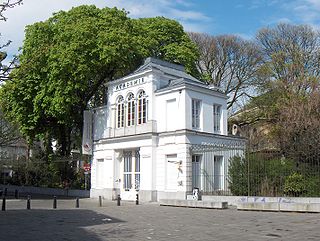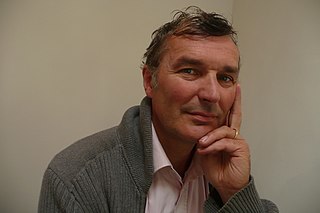Related Research Articles

Jugendstil was an artistic movement, particularly in the decorative arts, that was influential primarily in Germany and elsewhere in Europe to a lesser extent from about 1895 until about 1910. It was the German counterpart of Art Nouveau. The members of the movement were reacting against the historicism and neo-classicism of the official art and architecture academies. It took its name from the art journal Jugend, founded by the German artist Georg Hirth. It was especially active in the graphic arts and interior decoration.

Henry Clemens van de Velde was a Belgian painter, architect, interior designer, and art theorist. Together with Victor Horta and Paul Hankar, he is considered one of the founders of Art Nouveau in Belgium. He worked in Paris with Samuel Bing, the founder of the first gallery of Art Nouveau in Paris. Van de Velde spent the most important part of his career in Germany and became a major figure in the German Jugendstil. He had a decisive influence on German architecture and design at the beginning of the 20th century.

Florence Marguerite Knoll Bassett was an American architect, interior designer, furniture designer, and entrepreneur who has been credited with revolutionizing office design and bringing modernist design to office interiors. Knoll and her husband, Hans Knoll, built Knoll Associates into a leader in the fields of furniture and interior design. She worked to professionalize the field of interior design, fighting against gendered stereotypes of the decorator. She is known for her open office designs, populated with modernist furniture and organized rationally for the needs of office workers. Her modernist aesthetic was known for clean lines and clear geometries that were humanized with textures, organic shapes, and colour.

Modern furniture refers to furniture produced from the late 19th century through the present that is influenced by modernism. Post-World War II ideals of cutting excess, commodification, and practicality of materials in design heavily influenced the aesthetic of the furniture. It was a tremendous departure from all furniture design that had gone before it. There was an opposition to the decorative arts, which included Art Nouveau, Neoclassical, and Victorian styles. Dark or gilded carved wood and richly patterned fabrics gave way to the glittering simplicity and geometry of polished metal. The forms of furniture evolved from visually heavy to visually light. This shift from decorative to minimalist principles of design can be attributed to the introduction of new technology, changes in philosophy, and the influences of the principles of architecture. As Philip Johnson, the founder of the Department of Architecture and Design at the Museum of Modern Art articulates:
"Today industrial design is functionally motivated and follows the same principles as modern architecture: machine-like simplicity, smoothness of surface, avoidance of ornament ... It is perhaps the most fundamental contrast between the two periods of design that in 1900 the Decorative Arts possessed ..."
Maarten Van Severen was a Belgian furniture designer and interior architect. He came from an artistic family: his father was the abstract painter Dan Van Severen while his brother, Fabian Van Severen, is also a designer. Maarten Van Severen started out studying architecture in Ghent, designing furniture from 1986 onward. He is considered one of the few Belgian designers who have achieved international success.

The Royal Academy of Fine Arts Antwerp is an art academy located in Antwerp, Belgium. It is one of the oldest of its kind in Europe. It was founded in 1663 by David Teniers the Younger, painter to the Archduke Leopold Wilhelm and Don Juan of Austria. Teniers was master of the Guild of St Luke—which embraced arts and some handicrafts—and petitioned Philip IV of Spain, then master of the Spanish Netherlands, to grant a royal charter to establish a Fine Arts Academy in Antwerp. It houses the Antwerp Fashion Academy.

Robin Day, OBE, RDI, FCSD was one of the most significant British furniture designers of the 20th century, enjoying a long career spanning seven decades. An accomplished industrial and interior designer, he was also active in the fields of graphics and exhibitions.

Barber Osgerby is a London-based industrial design studio founded in 1996 by British designers Edward Barber and Jay Osgerby. Historically named variously Barber Osgerby Associates, BOA, Barber & Osgerby and BarberOsgerby, the practice has been called Barber Osgerby since 2008. Barber and Osgerby's work encompasses interiors, furniture, lighting and product design as well as art and architectural-scale projects.
The Forum AID Award was a Nordic architecture and design award, given annually by the Swedish magazine Forum AID. AID is an acronym for the three subject-matters of the magazine - Architecture, Interior design and Design - and it is also the three categories of the award. It is given to the designers of the "Best Building [interior design and design in the Nordic Countries" that year. The award was founded in 2004 and is presented at a ceremony in Stockholm
Carl Gustav Magnusson is an industrial designer, inventor, design juror and lecturer.

Frans Schrofer is a Dutch furniture designer and industrial designer based in The Hague, Netherlands. He received a technical education in Leiden and then studied at the Design Academy Eindhoven, graduating in 1983 and founding his own design studio, Studio Schrofer, in 1984. He is known for a sculptural approach to furniture design, conscious use of materials, practicality, ergonomics, technical knowledge and for pioneering a modern, design-led approach to garden furniture styles.

Furniture created in the Art Nouveau style was prominent from the beginning of the 1890s to the beginning of the First World War in 1914. It characteristically used forms based on nature, such as vines, flowers and water lilies, and featured curving and undulating lines, sometimes known as the whiplash line, both in the form and the decoration. Other common characteristics were asymmetry and polychromy, achieved by inlaying different colored woods.
Noé Duchaufour Lawrance is a French interior and product designer born in France in 1974.
Xavier Lust is a furniture designer and sculptor based in Brussels. He is best known for the unique technique of shaping metal that he uses to make furniture. The simple and original shapes created by folding and curving metal sheets without a mould have become his work signature. He has collaborated with several furniture manufacturers including MDF Italia, Driade, De Padova, CerrutiBaleri, Kristalia, Fiam and Extremis.
Moooi is a Dutch furniture, interior, and lighting modern design company. It was founded by Marcel Wanders and Casper Vissers in the Netherlands in 2001.

Design Museum Gent is the only museum in Belgium with an international design collection. The museum complex, situated in the heart of the tourist centre of Ghent, comprises an imposing 18th-century mansion and a modern wing. The museum possesses a comprehensive and trend-setting collection of Belgian design, supported by international top-class objects. Its collection includes everything from the Art Nouveau of Henry van de Velde to contemporary avant-garde design.

Ruud-Jan Kokke is a Dutch designer who started his career in the mid-eighties and became known for his furniture, inventive objects, interiors and designs for public space. He has received numerous nominations and awards. He is married to the visual artist and jewellery designer Petra Hartman.

The Art Nouveau movement of architecture and design first appeared in Brussels, Belgium, in the early 1890s, and quickly spread to France and to the rest of Europe. It began as a reaction against the formal vocabulary of European academic art, eclecticism and historicism of the 19th century, and was based upon an innovative use of new materials, such as iron and glass, to open larger interior spaces and provide maximum light; curving lines such as the whiplash line; and other designs inspired by plants and other natural forms.

André Verroken was a Flemish and Belgian furniture designer and interior architect.
Linde Freya Tangelder is a Dutch furniture, product, and interior designer based in Belgium. She is the founder of the design studio Destroyer/Builders, which takes inspiration from human interactions with architectural elements, materials, or building techniques. Her designs are research-based and strive to find a balance between contemporary and traditional elements.
References
- ↑ Dirk Wynants at Style Park